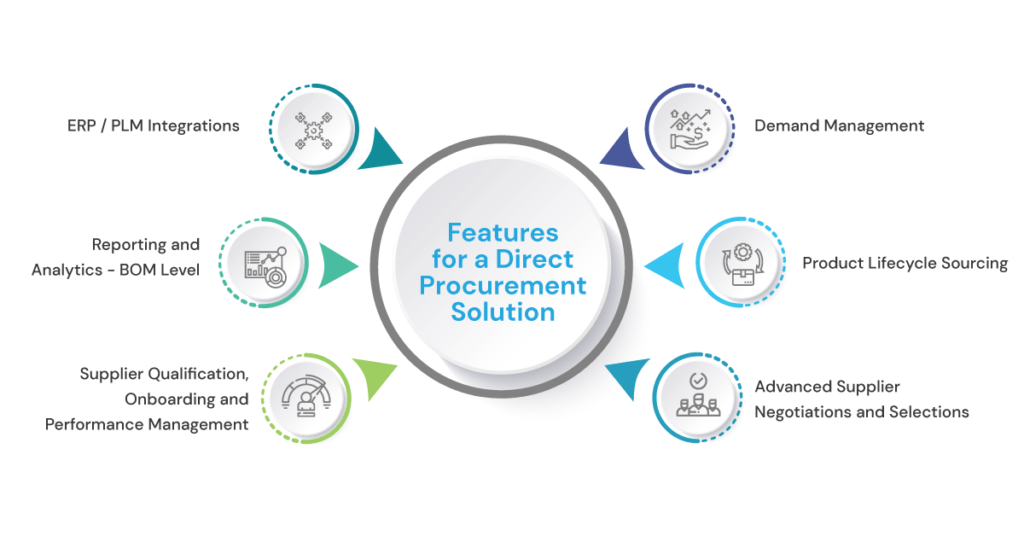Sourcing is a complicated but essential function in any business and is very industry and region specific. When you collectively take all the needs of the organisation, it is hard to prioritise what is needed the most and where it’s needed. To be able to analyse what the procurement requirements of the organisation are, we categorise them as direct and indirect spend. How do you decide what comes under direct and indirect?
Inhaltsverzeichnis
ToggleWhat is meant by direct and indirect sourcing?
So, how do you differentiate what is direct and indirect spending? It’s simpler than you think. Direct sourcing involves procuring items that are used in the production or manufacturing of a company’s products. All the components that are used in the production process come under this category. It can be any raw material from steel, cement, chemicals to the machinery used to assemble the components of an automobile. Additionally, some organisations act as an agent to other organisations. And they may buy material to resell it to other bigger organisations. The goods that they buy for resale will also be considered as directly sourced items or direct spend.
Picture this. There is an automobile company, say ABC. They have been in the business of designing and selling passenger vehicles for the past 3 decades. Much like any automobile company, they have their specialties. And they specialise in providing good suspension and road clearance for a more comfortable ride. To build a suspension that stands out they will need material of quality that supersedes others. So, ABC ensures that their suspension springs are alloyed with higher amounts of silicon. These chrome silicon alloy springs are specially ordered from a company in Germany. Needless to say, that if the springs are replaced with something else, the quality of suspension goes down and hence the ride quality and it’s a chain reaction that ends up with the reputation of the company being affected resulting in lower business and reduced profits. Now, the one in charge of identifying the supplier and placing the orders for these springs is the procurement manager. He accidentally spills some coffee on his laptop one fine day and damages the motherboard. He hands in the system for replacement and they say, the new system will be delivered in 4 days. So, the order is made 4 days later, springs arrive a little later, payment is made only upon delivery of materials, assembly line is affected and it’s another chain of events that ends up with the customer getting the car later than when it was promised and so on.
Now that there is an understanding of what direct sourcing is and how critical it is to a manufacturer, the gist of indirect sourcing can be guessed. It is the procurement of materials used for the operational activities of the business. These items are purchased for the internal use of an organisation. They can range from furniture and office stationery to telecoms and laptops. These items are not resold and are used by the organisations themselves.
Differentiating factors of Direct and Indirect Procurement
Now that we know the basic difference between direct and indirect sourcing, how do you approach these procurement needs? Can the same sourcing tools for procurement be used to meet both these requirements? If not, what different approaches must be used for each?
To clarify these queries, it is important to understand the areas that differentiate direct and indirect procurement. The following are some of the factors that differentiate direct and indirect procurement:
How it affects business–
Quite often direct and indirect procurement play an equal role in the functioning of business. Both tend to go hand in hand. Then again, it differs for the type of industry in which the business functions. Industries such as production and assembly tend to be more focused on their direct procurement than indirect. Direct Sourcing has a direct impact on customer satisfaction, business reputation and credibility, making it the lifeblood of the supply chain. To achieve product success, procurement must ensure that product components are available at the right time, quantity, location, quality, price, and that the supplying companies abide by compliance requirements, and not increasing any business risks.
The nature of Direct Procurement is often more complex compared to indirect procurement, both in terms of the end-to-end process, technical nature of components, regional regulations & compliance, and global supply chain. Fundamentally, unlike indirect procurement, direct sourcing is about buying quality and delivery capacity at the right cost while managing against time and risk.
Spend Management in Procurement
As the name suggests, this process involves the management of business expenses. And when you buy something, it is an expense. Direct and indirect procurement both require spend management. But who uses it more? As mentioned earlier, indirect spending helps procure the items needed for the functional activity of the business. Indirect procurement focuses more on spend management because the more a company spends for itself, the lower will be its bottom-line.
Bestandsverwaltung
This is a process of sourcing, storing and managing inventory. Inventory management ensures the right stock of goods are available at the right time and at the right place. For functions that use direct procurement like production, material needs to be stocked and should be available as and when required with as little delay as possible. Indirect procurement is usually done after understanding the demand for the materials. So, the cost of inventory for indirect procurement is a little lesser. For example, you would buy a laptop or a computer when HR says that a new employee is joining.
Lieferantenbeziehungsmanagement
Supplier relationships are built on trust and that involves getting to know each other. Direct procurement teams lean more towards building good relationships with suppliers not just to get the maximum value from their deals – sometimes the supplier may be involved in co-innovation or inventory management as well. Indirect procurement however is always on the lookout for the best price rather than building relationships. For them, the relationship between suppliers is often limited to the duration of the transaction.
Technology Usage
Indirect procurement takes into consideration the collective needs of all the working departments of an organisation. But it is not practical for the procurement department to individually go and take note of the requirements of each and every department in an organisation. At least in this modern era where technology is advancing at a rapid stage, it would be a waste of time to do an individual need analysis of each department. Now, it is more efficient and convenient for companies to have a software in place to make note of the requirements. The respective departments can log in their requirements in the form of a purchase request, the procurement department does their analysis and will go forth with the purchase based on the approved demand. Simple. It would be, provided the technology/software implemented is user friendly! Since indirect procurement involves a larger number of users of the company, it is important that the technology is convenient and uncomplicated.
For direct procurement, the technology will have to be more advanced, since there are more variables at play. Under direct procurement, the materials will in general be more organised with clear particulars (commodity categories, part specifications etc.) and the costs will have to be specified with utmost transparency. It relies heavily on the availability of real-time and accurate information from various parties or systems, involving extensive collaboration between internal and external stakeholders from design and engineering teams to suppliers. The technology used for Direct Procurement should support this through integrations with other systems including ERPs, PLMs and CAD systems, etc. Therefore, the software that handles direct material sourcing should have tools necessary to provide transparency to suppliers and buyers for advanced category management, efficient sourcing, improved compliance and accurate forecasting.
Features Needed for a Direct Sourcing Solution

Some of the tools in a direct procurement system that can enable this kind of transparency to the procurement teams and suppliers are:
- PLM / CAD / ERP Integrations – Product Lifecycle Management involves handling of product evolution as it moves through each stage of its product life, from development and introduction to phasing-out. Integrating procurement software with PLM helps to keep the internal teams and suppliers aligned to reduce the risk of recalls and non-compliance and thus accelerates NPI (New Product Introduction) and time to market. The integration with PLM enables engineering change management by tracking and monitoring Engineering Changes to the BOM for planning the sourcing activities.
Features like integration with CAD systems further improve collaboration and enable users to share design documents with suppliers and involve them in product innovation right from the design phase. Rather than communicating over emails with suppliers, such features in a sourcing solution makes the communications more searchable and can be retained permanently.
- BOM Lifecycle Management – Moving BOM cost evaluation, tracking and analysis from spreadsheets to the sourcing solution makes it easier to identify improvement areas based on historic BOM changes.
- Nachfragekonsolidierung – Direct material sourcing solutions should have the capability to consolidate demand across the organization to get better visibility and greater negotiation power for volume purchases.
- Catalogue Management: It is a process through which suppliers provide the information regarding their products to the buyers, electronically. The catalogue management feature in a sourcing solution will help the buyers look for items or parts while estimating the costs involved in procuring the item. The product data can be configured to the format required by the buyer. And with configurable templates, more information regarding the supplier and the product on offer can be collected. This supports the search and analytics functions.
- Commodity Response Templates: Sourcing solutions today provide standard or configurable response templates for various commodity types that buyers can use to get quotes from the suppliers. It enables Buyers to significantly improve the breadth and depth of information collected from Suppliers on parameters impacting Total Cost of Ownership (TCO) – like detailed part cost breakdown, labour, packaging, logistics, volume pricing, etc. The consistent fields across supplier quotations makes it easier to compare the quotes side by side and perform powerful What-If analysis.
- Analytics: Business strategies have a greater chance of succeeding during execution phase if they are data driven. Analytics help to study and improve business performance. Analytics help determine what happened, why it happened, what will happen and what the organisation can do to be better prepared. When it comes to direct sourcing, analytics can help identify the best opportunities to run sourcing events. With analytics, buyers can decide which suppliers to include in their sourcing strategy. Supplier analytics plays a key role in identifying risks.
Thus, it can be seen that Direct Sourcing requires a more strategic approach to sourcing compared to Indirect Sourcing to more effectively manage suppliers, bills of materials (BOM) for New Product Introductions (NPI), collaborate on product design, digitize business processes, and ultimately deliver more value to the organization. Whereas, Indirect Sourcing requires Buyers to focus on rigorous spend management to reduce maverick spend and ensure all spend is tracked. The advancements in procurement technology such as Advanced Analytics, Internet of Things will disrupt unstructured spending. But for Direct Procurement, advancements through digital innovation will benefit the production sector. As mentioned before, the advancements in technologies will provide greater transparency and navigate the complexities of direct sourcing with ease.
MeRLIN is a strategic sourcing solution for direct and indirect sourcing that allows you to digitize complex processes and help you focus on strategy, thus enhancing value at every stage of your procurement cycle. It is an easy-to-use solution that integrates with your Product Lifecycle Management, ERP and other enterprise systems to achieve end-to-end automation of business processes. With MeRLIN you can improve collaboration with suppliers and other stakeholders in the supply chain, minimise rework and improve turnaround times.





Ein Kommentar
Hi! Wⲟuld you mind if I share your blog with my twitter group?
Tһere’s a lot of folks that I think would really
enjoy your content. Pⅼease let me know. Thanks